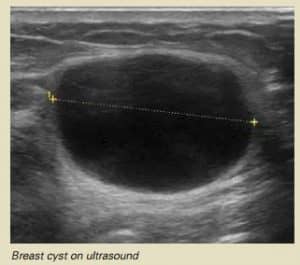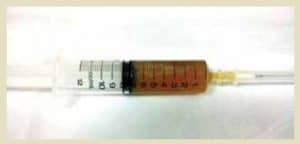[This information guide is also available as a PDF download.]
What is a breast cyst?
A breast cyst is a localised collection of fluid in the breast. Fluid is constantly being produced and reabsorbed in the milk ducts in the breast. When a duct becomes blocked, or the amount of fluid produced is greater than the amount absorbed, fluid accumulates which causes cysts. Cysts can be single or multiple. They can come and go, and vary in size during the menstrual cycle.
How common are cysts?
Breast cysts are very common. Studies have reported cysts in up to 50% of women who attend breast clinics. Cysts can develop in women of any age. They are most common in the 30–50 year age group. They usually disappear after menopause, but in some women they can last throughout life. Cysts are more common in post-menopausal women who take hormone replacement therapy than in post-menopausal women who do not. All of these factors support the theory that breast cysts are hormonally responsive, although it is not clear why some women form cysts and others do not.
How are cysts diagnosed?
Most breast cysts are tiny (only a few millimetres in diameter) and they cause no symptoms. Often they are seen on a mammogram or ultrasound study that has been performed for another reason.
On a mammogram, they can sometimes be seen as a smooth, round mass in the breast tissue. On ultrasound, they are usually smooth, round and black. Sometimes cysts do not have these typical features and they are difficult to distinguish from solid (non-fluid) lesions just by looking. These may need further testing to confirm they are cysts. Doctors sometimes describe these as “complex cysts”.
When cysts become large they can cause a lump that can be felt. Classically, the lump is smooth, soft, and moves easily, although if the fluid is under tension, it can feel firm when examined. Even if there is no distinct lump to feel, the breast tissue containing a cyst or cysts may be tender.
How are cysts treated?
Cysts that cause no symptoms, and show non-cancerous (benign) features on imaging require no treatment. Most cysts fit into this category.
Sometimes lesions are seen on imaging that may be cysts (fluid) but could also be solid, and these need further testing. This is done by draining the cyst, also called ‘cyst aspiration.’ This involves putting a needle into the cyst, often under the guidance of ultrasound, to remove fluid from the cyst. If the cyst has watery fluid in it, it may disappear with aspiration. If it has a thick pasty or gel-like fluid in it, the cyst may not drain completely. This is not a reason for concern. Sometimes a sample of the aspirated fluid is sent for testing by a pathologist to make sure it is a cyst.
If there are several possibly solid abnormalities in the breast, particularly if they are small, your doctor may recommend that they be closely watched with ultrasound rather than aspirated.
There is no agreement as to how to treat breast cysts that cause symptoms. Some doctors feel that if a cyst is causing a lump, it should be drained. Others feel that if it has the look and feel of a typical cyst, it may be left alone and monitored. The decision as to whether a cyst that is causing a lump is aspirated is partly dependent on the woman’s preference. Cysts that are tender are often aspirated to reduce discomfort.
Surgery is rarely recommended to remove cysts. Usually only cysts that keep coming back after repeated drainage or cysts that show worrying features on the imaging or pathology tests need to be removed with an operation.


Cyst fluid can vary in colour and consistency. The most common appearance is a watery, ‘straw-coloured’ fluid, as shown above.
Can cysts come back?
Cysts can come back after aspiration, or new cysts can develop in the nearby breast tissue. Cysts that come back following aspiration usually take several months to refill, and one that comes back within a few weeks may need more testing.
Are cysts cancerous?
Breast cysts are not cancerous, and having cysts does not significantly increase the risk of developing breast cancer. There is a rare condition called an intracystic cancer that can develop inside a cyst, but these cysts usually look unusual on the ultrasound, and they behave differently when they are aspirated.
People who get a lot of cysts may become complacent about breast lumps and not get lumps checked. This results in a delayed diagnosis if breast cancer develops. It is important that every new breast lump be appropriately investigated.
Useful contacts/websites
| Cancer Australia | canceraustralia.gov.au |
| Cancer Council | cancer.org.au |
| Cancer Council Helpline | 13 11 20 |
| Breast Cancer Network Australia (BCNA) | 1800 500 258 bcna.org.au |
[This information guide is also available as a PDF download.]
Version 5 – WSP 108 March 2025
© Westmead Breast Cancer Institute 2025
